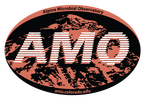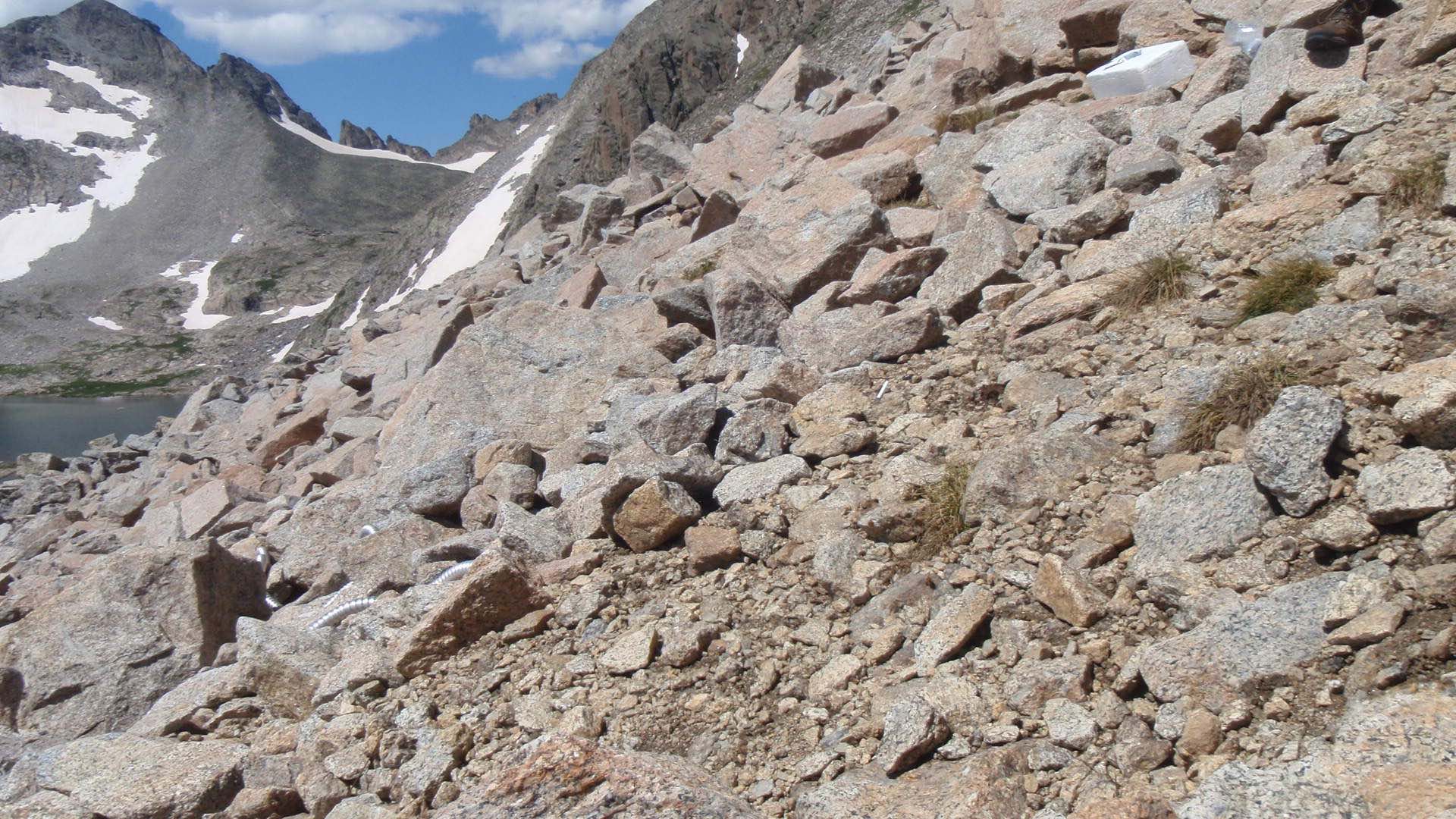Moving Up Hill
Microbe-plant interactions facilitating biotic adaptation to climate change.
This is a joint project with the Suding lab. The major goals of this project are to understand the role of microbe-plant interactions in plant species distributions, that is, how these interactions affect plant colonization of high elevation sites and to explain the mechanisms of microbial and plant distribution shifts in response to climate change. We are testing 4 hypotheses at our sites in Colorado:
1) that distributional models that do not include plant-microbial associations will under predict plant species presence and spread at extreme elevations;
2) that soil microbes facilitate plant establishment at upper distribution limits by increasing tolerance to cold, drought, and low nutrient stress;
3) that microbial communities will facilitate the colonization of plant species into areas previously outside their distributional limits as the climate changes
4) that interaction networks affect the development of diversity patterns as plants track a changing climate.
Funding for this work is through a collaborative grant with Katie Suding's lab : NSF DEB1457827 "Microbial facilitation at the leading edge of plant species distributional shifts".
This is a joint project with the Suding lab. The major goals of this project are to understand the role of microbe-plant interactions in plant species distributions, that is, how these interactions affect plant colonization of high elevation sites and to explain the mechanisms of microbial and plant distribution shifts in response to climate change. We are testing 4 hypotheses at our sites in Colorado:
1) that distributional models that do not include plant-microbial associations will under predict plant species presence and spread at extreme elevations;
2) that soil microbes facilitate plant establishment at upper distribution limits by increasing tolerance to cold, drought, and low nutrient stress;
3) that microbial communities will facilitate the colonization of plant species into areas previously outside their distributional limits as the climate changes
4) that interaction networks affect the development of diversity patterns as plants track a changing climate.
Funding for this work is through a collaborative grant with Katie Suding's lab : NSF DEB1457827 "Microbial facilitation at the leading edge of plant species distributional shifts".
Below: Plants are slowly invading this "snowbed" site near D1 in the Green Lakes Valley. Photo taken August 12, 2014, just after snow melt. For more photos see Colorado field sites.
Relevant publications (reverse chronological order):
Darcy J.L. et al. 2018. Phosphorus, not nitrogen, limits plants and microbial primary producersfollowing glacial retreat. Science Adv 4: eaaq0942
Bueno de Mesquita, CP, et al.. 2017. Plant colonization of moss-dominated soils in the alpine: Microbial and biogeochemical implications. Soil Biol. Biochem.111: 135-142.
Castle S.C. et al.. 2017. Nutrient limitation of soil microbial activity during the earliest stages of ecosystem development. Oecologia 185: 513-524.
Knelman JE et al.. Rapid Shifts in Soil Nutrients and Decomposition Enzyme Activity in Early Succession Following Forest Fire. Forests 8: doi:10.3390/f8090347
Bueno de Mesquita C.P. et al.. 2016. Incorporating biotic factors in species distribution modeling: are interactions with soil microbes important? Ecography 38: 970-980 [Reprint].
Castle, S.C., 2016. Biogeochemical drivers of microbial community convergence across actively retreating glaciers. Soil Biol Biochem 101: 74-84. [Reprint]
Schmidt, S.K. et al. 2016. Biogeochemical stoichiometry reveals P and N limitation across the post-glacial landscape of Denali National Park, Alaska. Ecosystems19: 1164–1177.
Knelman J.E. et al.. 2015. Plant colonization effects on bacterial community structure, microbial biomass, and soil enzyme activity ....... Soil Biol Biochem 90:161-168.[Reprint]
Schmidt S.K. et al. 2015. Plant-microbe interactions at multiple scales across a high-elevation landscape. Plant Ecology and Diversity 8: 703-712. [Reprint]
King A.J., et al. 2012. Co-occurrence patterns of plants and soil bacteria in the high-alpine subnival zone track environmental harshness. Frontiers Microbiology. 3: [Reprint]
King A.J., et al. 2010. Biogeography and habitat modelling of high-alpine bacteria. Nature Comm. 1:53 doi: 10.1038/ncomms1055. [Reprint]
Schmidt S.K. et al. 2008. Mycorrhizal and dark-septate fungi in plant roots above 4270 meters elevation in the Andes and Rocky Mountains. Arctic Antarctic Alpine Res. 40: 576-583. [Reprint]
Freeman, K.R. et al.. 2009. Soil CO2 flux and photoautotrophic community composition in high-elevation, “barren” soils. Environ. Microbiol. 11: 674-686. [Reprint]
Mullen R.B.. 1993. Mycorrhizal infection, phosphorus uptake, and phenology in Ranunculus adoneus: Implications for the functioning of mycorrhizae in alpine systems. Oecologia 94: 229-234.
Darcy J.L. et al. 2018. Phosphorus, not nitrogen, limits plants and microbial primary producersfollowing glacial retreat. Science Adv 4: eaaq0942
Bueno de Mesquita, CP, et al.. 2017. Plant colonization of moss-dominated soils in the alpine: Microbial and biogeochemical implications. Soil Biol. Biochem.111: 135-142.
Castle S.C. et al.. 2017. Nutrient limitation of soil microbial activity during the earliest stages of ecosystem development. Oecologia 185: 513-524.
Knelman JE et al.. Rapid Shifts in Soil Nutrients and Decomposition Enzyme Activity in Early Succession Following Forest Fire. Forests 8: doi:10.3390/f8090347
Bueno de Mesquita C.P. et al.. 2016. Incorporating biotic factors in species distribution modeling: are interactions with soil microbes important? Ecography 38: 970-980 [Reprint].
Castle, S.C., 2016. Biogeochemical drivers of microbial community convergence across actively retreating glaciers. Soil Biol Biochem 101: 74-84. [Reprint]
Schmidt, S.K. et al. 2016. Biogeochemical stoichiometry reveals P and N limitation across the post-glacial landscape of Denali National Park, Alaska. Ecosystems19: 1164–1177.
Knelman J.E. et al.. 2015. Plant colonization effects on bacterial community structure, microbial biomass, and soil enzyme activity ....... Soil Biol Biochem 90:161-168.[Reprint]
Schmidt S.K. et al. 2015. Plant-microbe interactions at multiple scales across a high-elevation landscape. Plant Ecology and Diversity 8: 703-712. [Reprint]
King A.J., et al. 2012. Co-occurrence patterns of plants and soil bacteria in the high-alpine subnival zone track environmental harshness. Frontiers Microbiology. 3: [Reprint]
King A.J., et al. 2010. Biogeography and habitat modelling of high-alpine bacteria. Nature Comm. 1:53 doi: 10.1038/ncomms1055. [Reprint]
Schmidt S.K. et al. 2008. Mycorrhizal and dark-septate fungi in plant roots above 4270 meters elevation in the Andes and Rocky Mountains. Arctic Antarctic Alpine Res. 40: 576-583. [Reprint]
Freeman, K.R. et al.. 2009. Soil CO2 flux and photoautotrophic community composition in high-elevation, “barren” soils. Environ. Microbiol. 11: 674-686. [Reprint]
Mullen R.B.. 1993. Mycorrhizal infection, phosphorus uptake, and phenology in Ranunculus adoneus: Implications for the functioning of mycorrhizae in alpine systems. Oecologia 94: 229-234.


